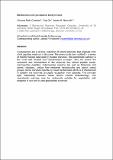Files in this item
Mechanisms of cyanobactin biosynthesis
Item metadata
| dc.contributor.author | Melo Czekster, Clarissa | |
| dc.contributor.author | Ge, Ying | |
| dc.contributor.author | Naismith, James H. | |
| dc.date.accessioned | 2017-09-14T23:32:29Z | |
| dc.date.available | 2017-09-14T23:32:29Z | |
| dc.date.issued | 2016-12 | |
| dc.identifier | 245863580 | |
| dc.identifier | 071c79df-38b2-408a-8c57-b8875e14e75f | |
| dc.identifier | 84988372916 | |
| dc.identifier | 000391905800013 | |
| dc.identifier.citation | Melo Czekster , C , Ge , Y & Naismith , J H 2016 , ' Mechanisms of cyanobactin biosynthesis ' , Current Opinion in Chemical Biology , vol. 35 , pp. 80-88 . https://doi.org/10.1016/j.cbpa.2016.08.029 | en |
| dc.identifier.issn | 1367-5931 | |
| dc.identifier.other | RIS: urn:F35E16F446E75CE8826153B584516BD9 | |
| dc.identifier.uri | https://hdl.handle.net/10023/11669 | |
| dc.description | This work was supported by the European Research Council (339367), UK Biotechnology and Biological Sciences Research Council (K015508/1). | en |
| dc.description.abstract | Cyanobactins are a diverse collection of natural products that originate from short peptides made on a ribosome. The amino acids are modified in a series of transformations catalyzed by multiple enzymes. The patellamide pathway is the most well studied and characterized example. Here we review the structures and mechanisms of the enzymes that cleave peptide bonds, macrocyclise peptides, heterocyclise cysteine (as well as threonine and serine) residues, oxidize five-membered heterocycles and attach prenyl groups. Some enzymes operate by novel mechanisms which is of interest and in addition the enzymes uncouple recognition from catalysis. The normally tight relationship between these factors hinders biotechnology. The cyanobactin pathway may be particularly suitable for exploitation, with progress observed with in vivo and in vitro approaches. | |
| dc.format.extent | 9 | |
| dc.format.extent | 15070167 | |
| dc.language.iso | eng | |
| dc.relation.ispartof | Current Opinion in Chemical Biology | en |
| dc.subject | QD Chemistry | en |
| dc.subject.lcc | QD | en |
| dc.title | Mechanisms of cyanobactin biosynthesis | en |
| dc.type | Journal item | en |
| dc.contributor.sponsor | European Research Council | en |
| dc.contributor.sponsor | BBSRC | en |
| dc.contributor.institution | University of St Andrews. School of Chemistry | en |
| dc.contributor.institution | University of St Andrews. EaSTCHEM | en |
| dc.contributor.institution | University of St Andrews. Biomedical Sciences Research Complex | en |
| dc.identifier.doi | 10.1016/j.cbpa.2016.08.029 | |
| dc.description.status | Peer reviewed | en |
| dc.date.embargoedUntil | 2017-09-14 | |
| dc.identifier.grantnumber | NCB-TNT | en |
| dc.identifier.grantnumber | BB/K015508/1 | en |
This item appears in the following Collection(s)
Items in the St Andrews Research Repository are protected by copyright, with all rights reserved, unless otherwise indicated.

